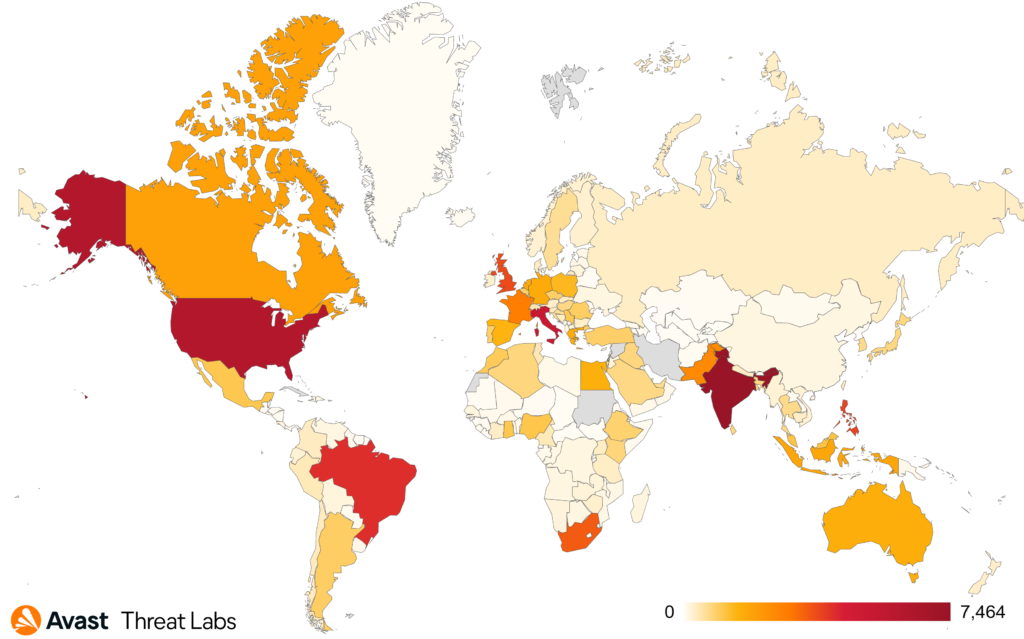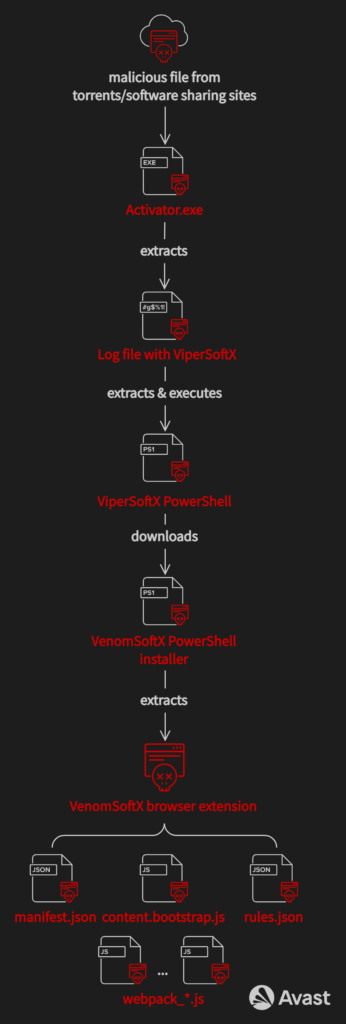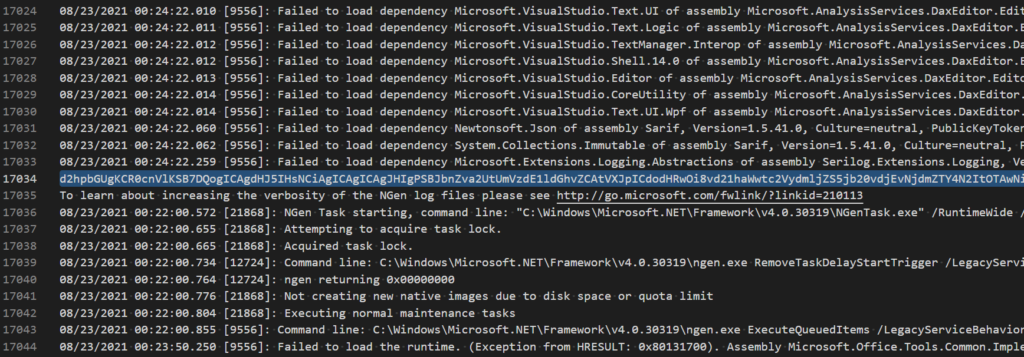We’ve been closely monitoring an information stealer called ViperSoftX. ViperSoftX was first reported on Twitter in 2020, and by Fortinet in the same year. Some aspects of ViperSoftX were also described previously by Colin Cowie. However, it has undergone very intensive development since then, intensifying throughout 2022. The malware authors’ constant game of hide-and-seek in which they continually improve their strategies and techniques to avoid detections shows no signs of stopping. We, therefore, decided to put the pieces together to provide a comprehensive analysis.
This multi-stage stealer exhibits interesting hiding capabilities, concealed as small PowerShell scripts on a single line in the middle of otherwise innocent-looking large log files, among others. ViperSoftX focuses on stealing cryptocurrencies, clipboard swapping, fingerprinting the infected machine, as well as downloading and executing arbitrary additional payloads, or executing commands.
One of the payloads ViperSoftX distributes is a specific information stealer in the form of a browser extension for Chromium-based browsers. Due to its standalone capabilities and uniqueness, we decided to give it its own name, VenomSoftX. The malicious extension provides full access to every page the victim visits, carries out man-in-the-browser attacks to perform cryptocurrency addresses swapping by tampering with API requests’ data on popular cryptocurrency exchanges, steals credentials and clipboard content, tampers with crypto addresses on visited websites, reports events using MQTT to the C&C server, and more.
ViperSoftX is mostly spread via cracked software such as Adobe Illustrator, Corel Video Studio, Microsoft Office, and more, commonly distributed over torrents.
Campaign overview
Since the beginning of 2022, we have protected more than 93,000 of our users. As the malware is mostly spread via torrents and software-sharing sites, ViperSoftX activity is distributed all over the world. The most impacted countries are India (7,000+), USA (6,000+), and Italy (5,000+).

Monetary gain
Both ViperSoftX and VenomSoftX focus on stealing cryptocurrencies from infected computers, either by scanning local files or by using more sophisticated techniques. In the table below, we show an estimation of the attackers’ total earnings for relevant cryptocurrency wallets.
| Cryptocurrency | Earnings in cryptocurrency | ~Earning in USD |
| Bitcoin | 5.947 BTC | $116,812.81 |
| Ethereum | 5.312 ETH | $7,826.13 |
| Dogecoin | 34,355.528 DOGE | $3,474.47 |
| Bitcoin Cach | 9.11997194 BCH | $1,021.39 |
| Cosmos (ATOM) | 65.153 ATOM | $846.44 |
| Tezos | 191.445553 XTZ | $241.32 |
| Dash | 4.72446445 DASH | $199 |
Table with monetary gain (data refreshed 2022-11-08)
The amounts in the wallets ViperSoftX and VenomSoftX redirect stolen cryptocurrencies to add up to about $130,421.56, as of November 8, 2022. This is just the amount sent to cryptocurrency wallets, and doesn’t include other possible profits from other activities.
Technical analysis
Overview of the infection chain

From cracked software to fake logs
In the beginning, ViperSoftX is served to victims when they download what they believe to be cracked software. It is commonly named Activator.exe or Patch.exe. Upon execution, however, the victim is infected with ViperSoftX.
Activator.exe extraction
Activator.exe is in fact a loader that decrypts data from itself using AES in CBC mode.
The decryption algorithm performs a checksum as follows:
- Read 4 bytes at offset
0x24from the end of the file which gives an offset - Hash the offset value using SHA256
- Read the rest of the bytes (from
-0x20) and compare it to the hash
If the checksum holds, the offset points to the location where the data is stored at offset+0x24 from the end of the binary. Since the data is stored from the end of the binary, offset is also the size of the data blob. This blob can be decrypted straight away using a hardcoded key as well as IV inside the binary:
| Key | 71C54C3BCFFCE591A70C0B5BA6448327BC975D89F3021053125F1CB9A7C0AF72 |
| IV | C0BA0B56EAC742AFD4CB680EE0EB4FB0 |
The decrypted data blob is a serialized protocol buffer structure. The structure template contains two protobuf messages as shown below:

We can use this template to deserialize the structure, revealing five different files:
- A log file with a hidden additional payload resulting in the
ViperSoftX PowerShell(see next subsections) XML filefor the task schedulerSyncAppvPublishingServer.vbs(clean) that is used to create a scheduled task for persistence- Application
binary(usually clean) that is supposed to be cracked Manifestfile
Last but not least, you can find the extraction Python script in our GitHub repository.
Analyzing the files
The most interesting file is the aforementioned “log file” which is usually more than 5 MB in size and contains a single malicious line of code (usually from 17,302 lines in total, but this might vary in different versions).
This log file is usually named and stored as:C:\Windows\Logs\system-logs.txt
although we saw variants dropping the same “log” files disguising as a “driver” or a “text” file, e.g.C:\Windows\System32\Drivers\p4kizn\e12de1ae-2139-45f6-b883-3c58243f23d6.sysC:\Windows\2ZQ2UoL\5A7C4B54-4404-4424-83DA-CC696BED43D3.txt
where the subfolder names and the GUIDs are randomized.
An example of such a malicious line can be found below. As we will see later, this line actually contains a script that is decoded and executed.

The malware creates a scheduled task using the legacy SyncAppvPublishingServer.vbs script for executing these hidden scripts afterward as well for ensuring persistence. Note that the line number varies depending on the malware configuration provided in the scheduled task.
Hidden Script Variants
We have seen two variants of hidden scripts lurking in the logs so far.
The first variant is a simple dropper that downloads another payload from a hardcoded C&C server and executes it. We have only seen the ViperSoftX information stealer downloaded as a payload so far. We will cover the stealer separately in the subsection below.

The second variant is in the form of a PowerShell script without the encoding. This script contains two parts, the first one is a set of decryption functions and the second is an encrypted data blob.

The script uses AES in CBC mode to decrypt the payload, the ViperSoftX stealer. The AES key is passed via the command line by the scheduled task created by Activator.exe. You can find the decryption process in this CyberChef template.
ViperSoftX Information Stealer
When the payload is dropped, an obfuscated ViperSoftX PowerShell script is presented to us. We have seen multiple variants of ViperSoftX, suggesting that the malware is under active development. In the text below, we will cover the stealer’s features as a whole.
Stealing Capabilities
First, let’s have a look at what ViperSoftX is actually capable of stealing. ViperSoftX performs fingerprinting of the infected machine, focusing on various types of information, including:
- Computer name
- Username
- OS information and its architecture
- Installed antivirus or other security software and whether the solution is active
The malware focuses on stealing cryptocurrencies. To do so, it searches the typical locations for web browser extensions and locally stored wallets. The full list of locations can be found in the Appendix. More generic information, such as OS, architecture, and username, is obtained using WMI and system variables.
ViperSoftX searches for cryptocurrencies stored locally on the infected device in cryptocurrency software and browser extensions, and monitors the clipboard for cryptocurrency wallet addresses to perform clipboard swapping.
The gathered data, as well as the fingerprint, is then concatenated together into a single string, encoded by base64, and sent to the hardcoded C&C server in the User-Agent HTTP header. Note that C&C servers vary across versions:http://api.private-chatting[.]com/connect
Each time the victim copies anything to their clipboard, ViperSoftX scans the content using predefined regular expressions in the background. If the expression matches one of the configured wallet addresses belonging to the specific cryptocurrency, the malware replaces the content with the attacker’s address and sends a notification to the C&C server in the X-Notify HTTP header in a form of three values:Cryptocurrency type - victim’s address - attacker’s address
The cryptocurrency type reflects what type of cryptocurrency was matched and can be one of the following: BTC, BCH, BNB, ETH, XMR, XRP, DOGE, or DASH.
The malware also checks title texts of opened windows (MainWindowTitle property) and if it spots an application focused on cryptocurrencies or finance, it logs its presence into:%SystemDrive%\Users\Public\log.dat
The full list of searched keywords can be found in the Appendix.
On top of the information-stealing core, ViperSoftX provides RAT functionalities as well, like executing arbitrary commands on the command line, downloading an additional arbitrary payload provided by the C&C server, and executing it, as well as removing itself completely from the system. The RAT functionality can also be used, for example, to steal cryptocurrencies from their locations, which it previously identifies and sends to the C&C server.
Host Header Spoofing
Aside from trying to steal cryptocurrencies, the malware spoofs host headers to obfuscate its communication with the C&C servers.
The spoofed host header consists of five to 10 lowercase alpha letters, but the true destination is in the hardcoded $meta_host variable. This way, the real C&C server address is obfuscated by a random-looking domain that doesn’t exist.

VenomSoftX Browser Extensions
Newer versions of ViperSoftX information stealer are capable of loading a custom malicious browser extension to Chromium-based browsers installed on infected computers. The extension is provided by the C&C server. The extension is basically another standalone information stealer, we are calling VenomSoftX, but is installed by ViperSoftX, as described below. The extension disguises itself as various popular browser extensions to avoid user detection.
The main goal VenomSoftX is also to steal cryptocurrencies from the unsuspecting victim. The difference is, VenomSoftX mainly does this by hooking API requests on a few very popular crypto exchanges victims visits/have an account with. When a certain API is called, for example, to send money, VenomSoftX tampers with the request before it is sent to redirect the money to the attacker instead. Although similar in principle to what information stealers like ViperSoftX do and rather a common clipboard swapping, this technique is performed at a lower level, meaning the victim has little to no chance of noticing the money is being transferred elsewhere.
Installing the extension
ViperSoftX’s approach is simple. The malware downloads a VenomSoftX PowerShell installer from the C&C server e.g. by base64-decoding a hardcoded request metadata directly from the PowerShell script, following a request to:http://apps-analyser[.]com/api/v1/<HASH>
depending on the malware version. This can hold different payloads, but we will focus on the VenomSoftX browser extension.
After the installer script is downloaded from the C&C server and the VenomSoftX browser extension is extracted, the installer searches several locations for .lnk files and if such a link file belongs to Chrome, Brave, Opera, or Edge, it modifies the link file with a parameter --load-extension=<path_to_the_malicious_extension>. This way, when the user starts their favorite browser, they actually load the malicious extension with it.
These locations are checked for link files leading to browsers:
%USERPROFILE%\Desktop%USERPROFILE%\OneDrive\Desktop%PUBLIC%\Desktop%ALLUSERSPROFILE%\Microsoft\Windows\Start Menu\Programs%APPDATA%\Microsoft\Windows\Start Menu\Programs%APPDATA%\Microsoft\Internet Explorer\Quick Launch\User Pinned\TaskBar
The extension ID is randomly generated, provided random lowercase characters to represent the extension folder and randomly generated version number of the extension:
$(Get-Random -Minimum 1 -Maximum 10).$(Get-Random -Minimum 1 -Maximum 10).$(Get-Random -Minimum 1 -Maximum 10)._0
We observed further versions of ViperSoftX containing a full update mechanism. These versions were able to walk through the modified .lnk files, parse the manifest.json file of the malicious extension, and when an older version or an old write timestamp of the extension was detected on the infected system than what was advertised by the C&C server, the malware requested an update and replaced the extension files to the newest version by a dedicated command (provided by the C&C server).
The extension tries to disguise itself as well known and common browser extensions such as Google Sheets. In reality, the VenomSoftX is yet another information stealer deployed onto the unsuspecting victim with full access permissions to every website the user visits from the infected browser.

Diving into javascript shenanigans
The extension contains several files, as shown in the table below. Each file has a different purpose:
| File name | Purpose |
| 128.png | Google Sheets icon to disguise the extension |
| content.bootstrap.js | Orchestrates the malicious activity, sends results using MQTT |
| manifest.json | The extension’s manifest file |
| rules.json | URL filter rules for Kucoin |
| webpack_block.js | Request tampering and credential theft on Blockchain.com |
| webpack_bnb.js | Request tampering and cryptocurrency theft on Binance |
| webpack_cb.js | Request tampering and cryptocurrency theft on Coinbase |
| webpack_common.js | Contains an address book for pattern matching, clipboard monitoring and stealing |
| webpack_content.js | When no exchange is detected – attacker’s addresses are replaced on the visited websites with the ones that victim entered earlier |
| webpack_gt.js | Request tampering and cryptocurrency theft on Gate.io |
| webpack_kuc.js | Request tampering and cryptocurrency theft on Kucoin |
The malware focuses on five big cryptocurrency exchanges, reflected by abbreviations in the modules names.
In the paragraphs below, we’ll focus on what each of the modules do, in detail.
content.bootstrap.js
This module is the starting point of VenomSoftX and it is loaded with every site visit. It orchestrates what modules to load and it is also responsible for sending stolen data to the C&C server.
The scripts are loaded depending on the visited domain. The bootstrap checks what site is being loaded and if it is one of the following: Blockchain.com, Binance, CoinBase, Gate.io, or Kucoin, the module loads an appropriate “webpack”. If the user is on any other site, webpack_content.js is loaded. The module webpack_common.js is loaded by default regardless of which site the victim visits.

All the modules serve their own purpose. However, two of the modules, webpack_common.js and webpack_block.js, are capable of sending data back to the collector server using a Paho MQTT client present in the content.bootstrap.js. The MQTT client has an event listener set to a hardcoded value b8b0becb-080a-46af-9688-e3671fcc4166 that indicates data should be sent to an MQTT broker, harvesting the data:broker.emqx[.]io
Note that the collector address can vary in different versions.
The sent data are structured as follows:MSG: time: <utc_datetime>
ip: <client_ip>
data: <data>
The time and ip fields are obtained using a public service (https://worldtimeapi.org/api/ip).
The data field is either clipboard content with a cryptowallet and other metadata, or stolen credentials for blockchain.com. See further sections below for details.
webpack_common.js
The “common” module is loaded to every website, regardless of whether it is a cryptocurrency exchange or something else. It is used to define an address book with regular expression patterns, which is used for crypto address matching on several occasions in other modules.
The structure of the address book is in the form of a dictionary, where the key is the regular expression and the value is yet another dictionary containing three values: coin, address, and network. An example of such an address book can be seen in the below snippet. For the full address book, see Appendix.

Furthermore, each time the user pastes anything into any website (except the malicious address from the address book), this module checks whether the clipboard content matches any of the regular expressions from the address book and if they do, it sends the following data to the collector server encoded using base64. The data for the MQTT message has a following construct:
Action
Site: <URL>
Browser: <USER-AGENT>
Clipboard: <CLIPBOARD-WALLET-ADDRESS>
Time: <TIMESTAMP>
webpack_content.js
This module monitors two input elements for content the user fills into websites and it is loaded when the victim is outside of any of the mentioned exchange sites:
HTMLInputElementHTMLTextAreaElement
This is done by implementing hooks in getters of these elements to try to find a compatible crypto address for the user’s input and if found, the malware creates new localStorage entry with a combination of visited site and the compatible address:website_attackerAddress: userAddress
The compatible address is found when the provided address matches any of the regular expressions from the address book described in the previous section.
After that, a custom MutationObserver watches for dynamic changes in the site (e.g. loading the page, displaying a message sent earlier in the user’s messenger client, etc.) and if such a change occurs, the malware replaces all mentions of the malicious address (if found) with the user’s address using the localStorage. This effectively hides all traces of the malicious address in the website’s body.
Note that since the information is stored directly in the persistent localStorage, the functionality survives a browser restart, PC restart, or re-visiting the page anytime in the future. The victim has to clear the user data in their browser or uninstall the malware extension altogether to get rid of the malicious behavior.
For the sake of demonstrating this behavior, we decided to create a demo PoC of a simple page that illustrates the whole process of content tampering while the malware is active:
- First two buttons,
Attacker addressandUser address, fill in attacker address or user address to the “Dynamic content to be pasted” line on the webpage - “
Get value” button triggers the getter but the hook is inactive since the provided address doesn’t match cryptowallet address pattern (it is too short) - The user fills in a
compatible address - “
Get value” button creates alocalStorageentry with the entered address - The attacker’s address is always replaced with the one from
localStorage

Draining the victim’s accounts
As we already mentioned, VenomSoftX focuses on five different crypto exchanges/websites, namely on Blockchain.com, Binance, Coinbase, Gate.io, and Kucoin.
In these modules, the malware tries to tamper with API requests the sites use for several actions like money withdrawal or sending security codes. This is done by creating hooks on the API calls (or rather functions responsible for sending those requests), parsing their structure, and replacing the response’s body with the desired attacker’s contents – commonly meaning that the recipient’s address is replaced by the attacker’s one as well as the amount is set to the value of an available account balance if known. The request is then processed by the malware without the user noticing anything, completely draining the victim’s portfolio as a result.
Note that the user has little to no chance to notice this. In comparison to a rather common clipboard swapping, for example, this “swapping” is performed on a lower level. Since the transactions on blockchains/ledgers are inherently irreversible, when the user checks the transaction history of payments afterward, it is already too late.
The complete list of hooked API functions can be found in the Appendix. The only file that differs from the rest is webpack_block.js. This module focuses on www.blockchain.com and it tries to hook https://blockchain.info/wallet. It also modifies the getter of the password field to steal entered passwords. Once the request to the API endpoint is sent, the wallet address is extracted from the request, bundled with the password, and sent to the collector as a base64-encoded JSON via MQTT.
Since the rest of the hooks are the same on the higher level if we ignore API differences, we will use the Binance module as an illustration example.
The Binance module recognizes six different API calls invoking malicious interactions. When the user logs in to the site, it is expected that at some point the API functionhttps://www.binance.com/bapi/asset/v3/private/asset-service/asset/get-user-asset
will be called. VenomSoftX then parses and saves all assets available on the victim’s account. When the user tries to manipulate their savings, e.g. withdrawing their money, the malware intercepts the requesthttps://www.binance.com/bapi/capital/v3/private/capital/withdraw/apply
and tampers with the request body, modifying the address to redirect the money to the attacker’s address if a compatible attacker’s address was found. The amount of the request is also set to the maximum amount available obtained by the previous step. After the tampering, the request is passed further like nothing happened, effectively draining the victim’s wallet.
Conclusion
In this blog post, we took a closer look at ViperSoftX, a long-standing information stealer, and its malicious browser extension payload VenomSoftX. We described both information stealers’ infection chains, and how the original payload hides and decrypts on the infected system.
We described what both ViperSoftX and VenomSoftX steal and how the browser extension leverages its full access to every page the victim visits and carries out man-in-the-browser attacks by silently tampering with the API requests popular cryptocurrency exchanges use, resulting in draining the victim’s accounts.
Indicators of Compromise (IoC)
- GitHub repository: ViperSoftX
ViperSoftX
| File name | SHA256 |
| Activator.exe | e1dc058fc8282acb95648c1ee6b0bc36b0d6b5e6853d4f602df5549e67d6d11a |
| Hidden log script first variant | 0bad2617ddb7586637ad81aaa32912b78497daf1f69eb9eb7385917b2c8701c2 |
| Hidden log script second variant | 0cb5c69e8e85f44725105432de551090b28530be8948cc730e4b0d901748ff6f |
| ViperSoftX PowerShell | 23b9075dac7dbf712732bb81ecd2c21259f384eb79ae8fdebe29b7c5a12d0519 |
| ViperSoftX’s browser installer | 5c5202ed975d6647bd157ea494d0a09aac41d686bcf39b16a870422fa77a9add |
VenomSoftX
| File name | SHA256 |
| content.bootstrap.js | 3fe448df20c8474730415f07d05bef3011486ec1e070c67683c5034ec76a2fcb |
| manifest.json | 0de9a23f88b9b7bda3da989dce7ad014112d88100dceaabca072d6672522be26 |
| rules.json | 1d6845c7b92d6eb70464a35b6075365872c0ae40890133f4d7dd17ea066f8481 |
| webpack_block.js | 7107ab14a1760c6dccd25bf5e22221134a23401595d10c707f023f8ca5f1b854 |
| webpack_bnb.js | ddee23e2bfd6b9d57569076029371e6e686b801131b6b503e7444359d9d8d813 |
| webpack_cb.js | 947215a1c401522d654e1d1d241e4c8ee44217dacd093b814e7f38d4c9db0289 |
| webpack_common.js | 7b75c1150ef10294c5b9005dbcd2ee6795423ec20c512eb16c8379b6360b6c98 |
| webpack_content.js | d7dfc84af13f49e2a242f60804b70f82efff7680cddf07f412667f998143fe9c |
| webpack_gt.js | 4da1352e3415faa393e4d088b5d54d501c8d2a9be9af1362ca5cc0a799204b37 |
| webpack_kuc.js | 705deecbbb6fd4855df3de254057c90150255c947b0fb985ea1e0f923f75a95f |
C&C
| C&C |
| api.private-chatting[.]com |
| apps-analyser[.]com |
| wmail-blog[.]com |
| wmail-service[.]com |
Appendix
Scripts and tools
- Extractor for ViperSoftX’s initial payloads (commonly named
Activator.exe) - CyberChef template for decrypting the second variant of the hidden scripts in logs
List of wallet addresses
| Cryptocurrency | Address |
| ADA | addr1q9c27w7u4uh55sfp64ahtrnj44jkthpe7vyqgcpt73z9lrq7fw3juld8k2ksz2p82tv45j8yc5wzqmr4ladxyt0vjxrsf33mjk |
| ATOM | cosmos1mcah8lel6rxhlqsyrzpm8237cqcuzgyw70nm6f |
| BNB | bnb1u64a2n3jhw4yh73s84rc58v8wxrwp7r8jwakpr |
| BNB | bnb1vmwl54jxj9yvsgz33xtyuvqnurdjy2raqnttkq |
| BTC | 1L8EBHDeiHeumtcpcroaxBceXnWFiYU5dh |
| BTC | 1Pqkb4MZwKzgSNkaX32wMwg95D9NfW9vZX |
| BTC | 32Wx3dsHCCxyJZLwseFYkgeFqVk16tCCcF |
| BTC | 3JvBvRuBfYvB6MjzMornj9EQpxhq9W7vXP |
| BTC | bc1qn6ype8u5kgj672mvsez9wz9wt9wk22tzd5vprp |
| BTC | bc1qxgz2g8kn2kg0wqqrmctyxu5n925pnwphzlehaw |
| BTC | qq9yrhef7csy3yzgxgs0rvkvez440mk53gv8ulyu6a |
| BTC | qqh3g98z60rdl05044xxt7gkgncezmdfy5tja99z53 |
| DASH | XdxTmTFuHrcHnQQhfweAnHtExFB5BXmU1z |
| DASH | Xtwj8uGx77NYBUki1UCPvEhe4kHYi6yWng |
| DOT | 122zNSYNN2TSR2H5wBCX16Yyvq7qLFWo1d6Lvw2t9CNxMxt1 |
| DOGE | DDxhfK5wbJkRN25mAbBYk3ND4xLjiMRyNq |
| DOGE | DUUNTm23sVwLyiw27WW9ZPT9XfiWhB1Cvf |
| ETH | 0x12507F83Dde59C206ec400719dF80D015D9D17B6 |
| ETH | 0x884467182849bA788ba89300e176ebe11624C882 |
| KAVA | kava1emxzwjw84e0re7awgue9kp4gseesyqrttg69sm |
| SOL | 7j5bxiFPSsScScBEjLj9qud5Yc2CqXGmembX3hQBdFTd$ |
| USDT | TDJLMdJWPrKNMHuxgpQL8QPYgvdXTnWJao |
| XMR | 475WGyX8zvFFCUR9ufThrNRtJmzmU13gqH9GV2WgAjbR7FgRVCWzokdfVf2hqvRbDBaMzBm1zpDiBTpBgxLt6d7nAdEEhC4 |
| XMR | 48qx1krgEGzdcSacbmZdioNwXxW6r43yFSJDKPWZb3wsK9pYhajHNyE5FujWo1NxVwEBvGebS7biW9mjMEWdMevqMGmDJ6x |
| XRP | rH6dyKWNpcvFz6fQ4ohyDbevSxcxdxfSmz |
| XRP | rpzn8Ax7Kz1A4Yi8KqvzV43KYsa59SH2Aq |
| XTZ | tz1g6rcQAgtdZc8PNUaTUzrDD8PYuCeVj4mb |
| ZEC | t1XjiZx8EydDDRuLisoYyVifcSFb96a3YBj |
| ZIL | zil1aw3kyrymt52pq2e4xwzusdfce9e5tmewvshdrm |
Also in our GitHub.
ViperSoftX
List of monitored cryptocurrency locations
Complete list in our Github.
List of monitored window titles
| Monitored window titles |
| binance |
| coinbase |
| blockchain |
| voyager |
| blockfi |
| coindesk |
| etoro |
| kucoin |
| citi |
| paxful |
| paypal |
| huobi |
| poloniex |
| bittrex |
| kraken |
| bitfinex |
| bitstamp |
Also in our GitHub.
VenomSoftX
Address book
Complete list in our Github.
List of hooked API calls
| Blockchain.com |
| https://blockchain.info/wallet |
| Binance |
| https://www.binance.com/bapi/accounts/v1/protect/account/email/sendEmailVerifyCode |
| https://www.binance.com/bapi/accounts/v1/protect/account/email/sendMobileVerifyCode |
| https://www.binance.com/bapi/kyc/v1/private/risk/check/withdraw-pre-check |
| https://www.binance.com/bapi/capital/v3/private/capital/withdraw/apply |
| https://www.binance.com/bapi/asset/v3/private/asset-service/asset/get-user-asset |
| https://www.binance.com/bapi/capital/v1/private/capital/deposit/queryUserDepositAddress |
| Coinbase |
| https://www.coinbase.com/api/v3/coinbase.public_api.authed.sends.Sends/CreateSend |
| https://www.coinbase.com/api/v3/coinbase.public_api.authed.sends.Sends/CreateSendMax |
| https://www.coinbase.com/api/v3/coinbase.public_api.authed.accounts.Accounts/GetAccounts |
| https://www.coinbase.com/api/v3/coinbase.public_api.authed.sends.Sends/CommitSend |
| https://www.coinbase.com/graphql/query?&operationName=ReceiveContentQuery |
| Gate.io |
| https://www.gate.io/myaccount/second_confirm |
| Kucoin |
| https://www.kucoin.com/_api/payment/withdraw/safe-img |
| https://www.kucoin.com/_api/payment/withdraw/apply |
| https://www.kucoin.com/_api/account-front/query/currency-balance |
| https://www.kucoin.com/_api/payment/deposit-address/get |



